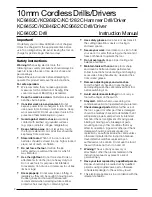
3
However, if the outer seal is broken and this
leakage gets on your skin:
•
Wash quickly with soap and water.
•
Neutralise with a mild acid such as lemon
juice or vinegar.
•
If battery liquid gets into your eyes, flush
them with clean water for a minimum of
10 minutes and seek immediate medical
attention. (Medical note: The liquid is a
25-35% solution of potassium hydroxide.)
•
Do not
attempt to open your drill/driver or
charger housings’ or the battery pack.
•
Do not
attempt to recharge non-rechargeable
batteries.
•
The supply cord of the charger should not be
replaced by the customer; if the cord is
damaged it should be replaced at an authorised
Black & Decker service centre.
•
Ensure that the battery pack is correct for the tool.
•
Ensure that the outside surface of the battery
pack or tool is clean and dry before plugging into
the charger.
•
Ensure that the battery is charged using the
correct charger recommended by the
manufacturer. Incorrect use may result in a
risk of electric shock, overheating or leakage of
corrosive liquid from the battery.
Save these instructions!
Electrical safety (UK only)
•
Your equipment is fitted with two core cable and
a non rewirable plug. The plug is fitted with a
3 amp fuse which should only be replaced with
an identical fuse approved to BS1362.
Note:
Fuses do not give personal protection against
electric shock.
•
After changing the fuse in your plug always
ensure the fuse cover is refitted. If the fuse cover
is missing or damaged do not use the plug.
For replacement or detachable fuse covers
contact a Black & Decker service centre.
•
Tools supplied with loose Black & Decker
extension cable and have a 13 amp plug fitted
are supplied with a 13 amp fuse, which is the
recommended fuse for the extension cable.
Note:
If a non Black & Decker extension cable is to
be used on this product the recommended fuse
stated in the literature should be fitted to the plug.
ENGLISH
Charger plug and cable
•
Do not tug at the cable to pull the plug from
the socket.
•
Make sure the cable is located so that it will not
be stepped on, tripped over, or otherwise
subjected to damage or stress.
•
Keep the cable away from heat, oil, sharp edges
and rough surfaces and always ensure it is in
good condition.
Additional drill and charger
safety rules
•
Danger!
240 volts are present at the charging
terminals. Do not probe with conductive objects
or you will risk an electric shock.
•
Danger!
If the energy pack case is cracked or
damaged, do not insert into the charger or you
will risk an electric shock.
•
The charger is designed for indoor use only.
•
Do not operate the charger
if it has received
a sharp blow, been dropped, or otherwise
damaged in any way. Take it to a Black & Decker
service centre.
•
Never
attempt to connect two chargers together.
•
Always disconnect the supply
before making
or breaking connections to the battery.
•
Be aware that this tool is always in an operating
condition, because it does not have to be
plugged into an electrical outlet. Keep the switch
control lever in the “Off” position when the tool is
not in use or when changing accessories.
•
When drilling or driving screws into walls, floors
etc., check wherever “live” electrical wires may
be encountered.
Do not touch any front metal
parts of the tool!
Hold the tool only by the
plastic housing.
•
The charger and drill/driver are specifically
designed to work together. Do not attempt to
charge the drill/driver with any other charger
than the one supplied with the tool.
•
Do not
store the tool in locations where the
temperature may reach or exceed 50˚C (120˚F)
(such as outside sheds or metal buildings
in summer).
•
Do not
charge your drill/driver when it or the air
temperature is below (+40˚F) 4˚C or above
(+105˚F) 40˚C. This is important and may prevent
serious damage to the battery.
•
Do not
incinerate the drill/driver even if it is
severely damaged or completely worn out.
The battery pack can explode in a fire. A small
leakage of liquid from the battery cells may occur
under extreme usage, charging or temperature
conditions. This does not indicate a failure.



































